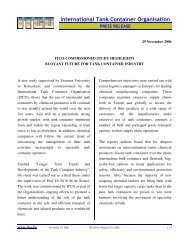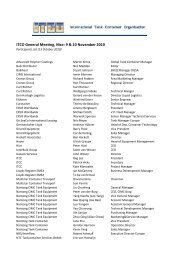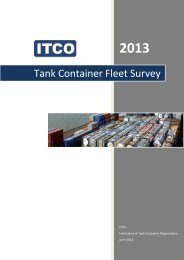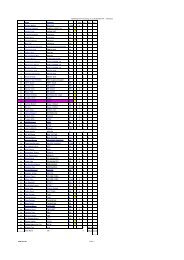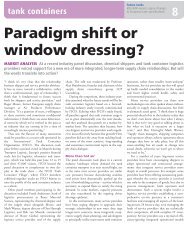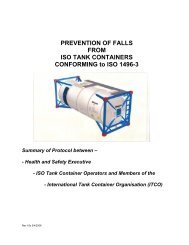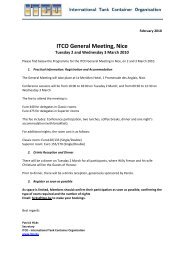Create successful ePaper yourself
Turn your PDF publications into a flip-book with our unique Google optimized e-Paper software.
ICHCA International <strong>Safe</strong>ty Panel Briefing Pamphlet No 30<br />
3.3 Compartments and Baffles<br />
3.3.1 The IMDG Code prescribe minimum filling rules for tank containers.<br />
Generally, these require tanks filled with free-flowing liquids, including<br />
liquefied gases, to be filled to not less than 80% <strong>of</strong> their volume. Further<br />
information on the rules governing the minimum and maximum degrees <strong>of</strong><br />
filling <strong>of</strong> tank containers laden with dangerous goods and goods not<br />
regulated as dangerous for transport are given in Annex 2 section A2.2.<br />
3.3.2 Baffles<br />
3.3.2.1 The majority <strong>of</strong> tank containers are built with a single chamber free from any<br />
sharp corner / edges. The smoothness <strong>of</strong> this simple internal design<br />
provides the operator with an easy to clean surface.<br />
3.3.2.2 Baffles (more properly known as surge plates within the IMDG Code) are<br />
required to ensure the longitudinal stability <strong>of</strong> the tank container is<br />
maintained when it is loaded to less than 80% <strong>of</strong> the pressure vessel’s<br />
volume.<br />
3.3.2.3 Baffles are fitted within the single chamber pressure vessel to reduce the<br />
free flow <strong>of</strong> liquids as the container is moved during transport. Picture 11<br />
shows the upper <strong>of</strong> two transverse surge plates fitted to the interior <strong>of</strong> a<br />
pressure vessel. However Picture 12 shows an example <strong>of</strong> a full diameter<br />
surge plate as is more commonly fitted than the design shown in Picture 11<br />
3.3.3 Compartments<br />
A limited number <strong>of</strong> tank containers are built with two or more discrete<br />
compartments. The single shell is constructed in the same manner as a<br />
normal tank container, except that one or more watertight bulkheads are<br />
welded across the shell’s cross section. Outwardly there will be loading and<br />
discharge valves and a manway for each compartment. Each <strong>of</strong> these<br />
compartments is capable <strong>of</strong> carrying a different cargo or in some cases it is<br />
possible to carry a single cargo in one compartment and leave the other<br />
compartments empty. See also section 10.2.6.<br />
3.3.4 Marking<br />
Picture 11 Picture 12<br />
3.3.4.1 At the time <strong>of</strong> writing this pamphlet there was no regulation or requirement to<br />
mark tank containers to indicate if they are fitted with baffles or built with<br />
compartments. However the IMDG Code requires that the water capacity at<br />
20ºC shall be marked on a corrosion resistant metal identification plate fitted<br />
to every portable tank. The plates should also show the water capacity <strong>of</strong><br />
each compartment at 20ºC. An entry shown in this section <strong>of</strong> the plate<br />
indicates that the tank container is divided into compartments but does not<br />
indicate the number <strong>of</strong> compartments unless there is more than one value<br />
shown.<br />
Page 6 ©ICHCA International Limited



